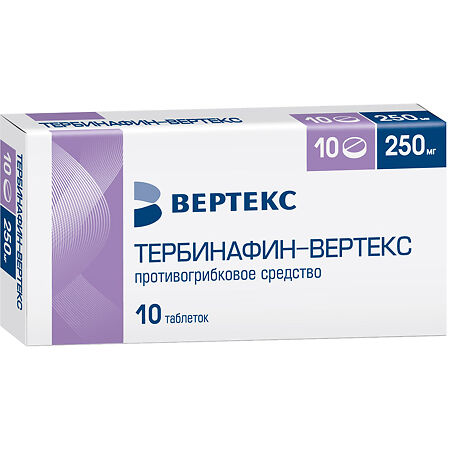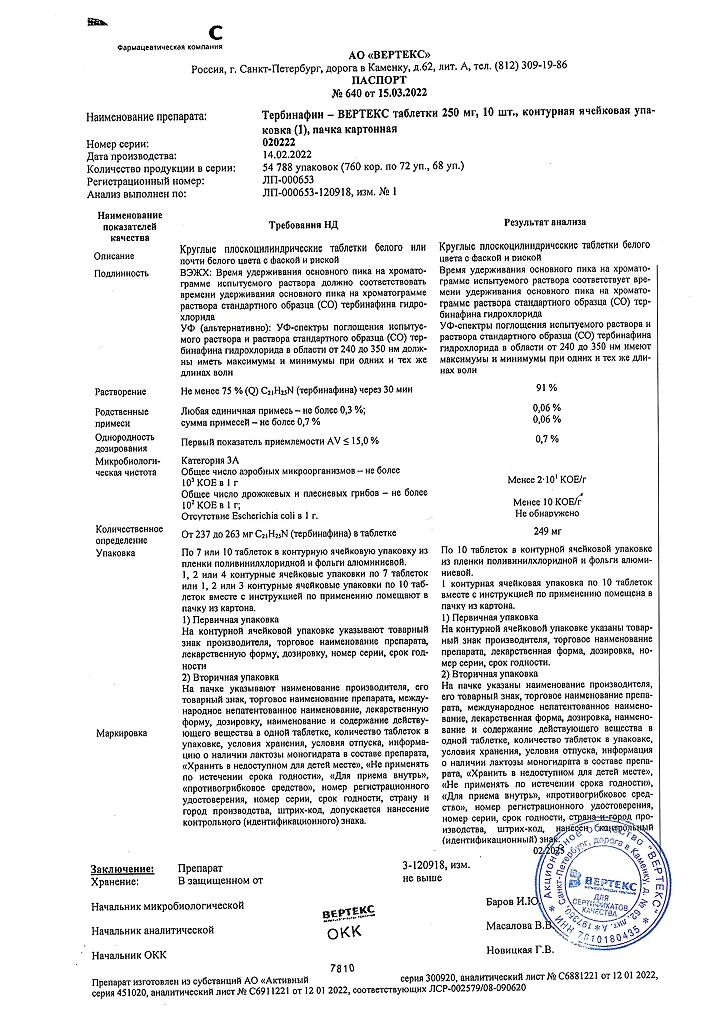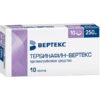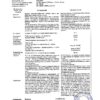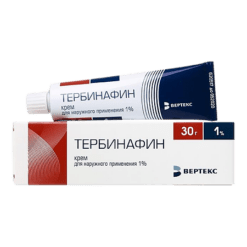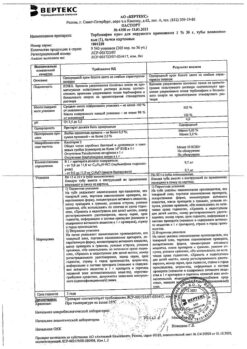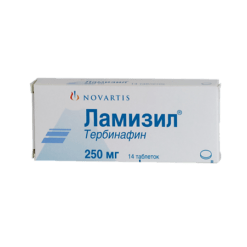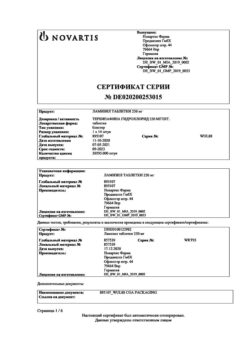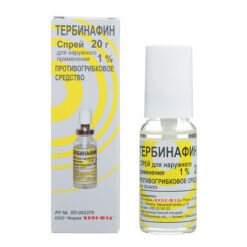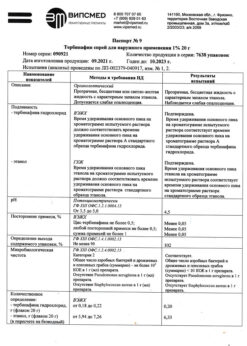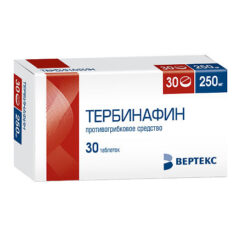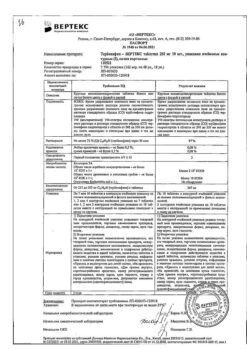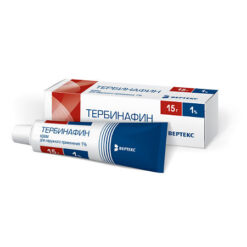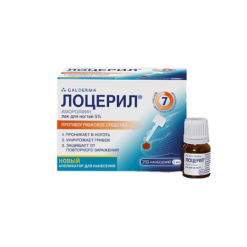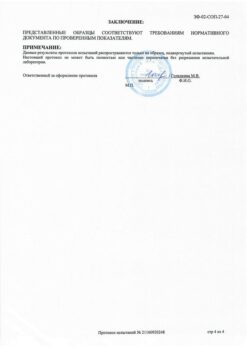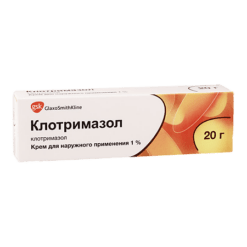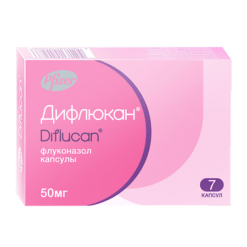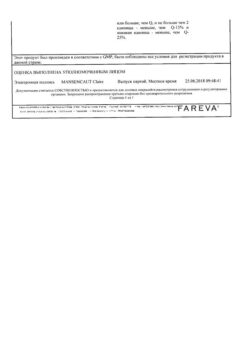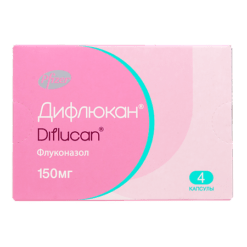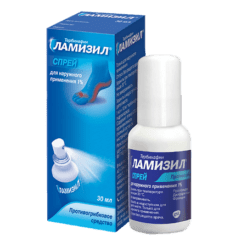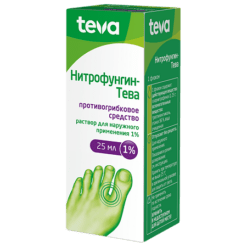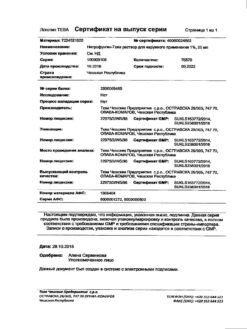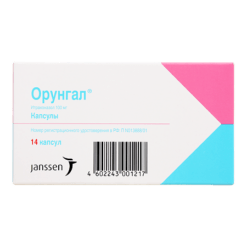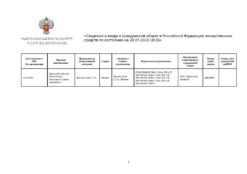No products in the cart.
Terbinafin-Vertex, tablets 250 mg 10 pcs
€12.25 €10.72
Description
Terbinafine is an antifungal agent. It has a broad spectrum of action against fungi that cause skin, hair and nail diseases, including:
- dermatophytes such as Trichophyton (e.g., T. rubrum, T. mentagrophytes, T. verrucosum, T. tonsurans, T. violaceum), Microsporum (e.g., M. canis), Epidermophyton floccosum;
- degenerative fungi of the genus Candida (e.g., C. albicans) and Pityrosporum.
In low concentrations terbinafine has fungicidal effect against dermatophytes, molds and some dimorphic fungi. Activity against yeast fungi, depending on their species, may be fungicidal or fungistatic.
The mechanism of action is associated with specific suppression of the early stage of sterol biosynthesis in the fungal cell. This leads to a deficit of ergosterol and to intracellular accumulation of squalene, which causes cell death of the fungus. The action of terbinafine is performed by inhibiting the enzyme squaleneepoxidase in the cell membrane of the fungus. This enzyme does not belong to the cytochrome P450 system. Terbinafine has no significant effect on the metabolism of hormones or other drugs.
Indications
Indications
Mycoses of the scalp (trichophytia, microsporia).
Fungal diseases of the skin and nails (onychomycosis) caused by Trychophyton (T. rubrum, T. mentagrophytes, T. verrucosum, T. violaccum), Microsporum (M. canis, M. gypseum) and Epidermophyton floccosum.
Severe, widespread dermatomycosis of smooth skin of the trunk and extremities, requiring systemic treatment.
Candidiasis of the skin and mucous membranes.
Pharmacological effect
Pharmacological effect
Terbinafine is an antifungal agent. Has a wide spectrum of action against fungi that cause diseases of the skin, hair and nails, including:
dermatophytes such as Trichophyton (eg T. rubrum, T. mentagrophytes, T. verrucosum, T. tonsurans, T. violaceum), Microsporum (eg M. canis), Epidermophyton floccosum;
yeast fungi of the genus Candida (for example, C. albicans) and Pityrosporum.
In low concentrations, terbinafine has a fungicidal effect against dermatophytes, molds and some dimorphic fungi. Activity against yeast fungi, depending on their type, can be fungicidal or fungistatic.
The mechanism of action is associated with the specific suppression of the early stage of sterol biosynthesis in the fungal cell. This leads to ergosterol deficiency and intracellular accumulation of squalene, which causes the death of the fungal cell. Terbinafine works by inhibiting the enzyme squalene epoxidase in the cell membrane of the fungus. This enzyme does not belong to the cytochrome P450 system. Terbinafine does not have a significant effect on the metabolism of hormones or other drugs.
Special instructions
Special instructions
If, during treatment with Terbinafine, the patient experiences phenomena that suggest liver dysfunction, such as unexplained persistent nausea, vomiting, lack of appetite, fatigue, jaundice, pain in the right hypochondrium, dark urine or discolored feces, in this case the hepatic origin of these symptoms should be confirmed (determining serum concentrations of ALT, AST) and treatment with Terbinafine should be discontinued. The patient should be warned about the need to consult a doctor if such symptoms occur.
Patients with impaired renal function (creatinine clearance less than 50 ml/min or serum creatinine level more than 300 µmol/l) should receive half the usual dose of the drug.
Active ingredient
Active ingredient
Terbinafine
Composition
Composition
1 tablet contains:
Active substance:
terbinafine hydrochloride 250 mg;
Excipients:
microcrystalline cellulose,
hyprolose (hydroxypropylcellulose),
croscarmellose sodium,
colloidal silicon dioxide,
calcium stearate,
lactose monohydrate
Contraindications
Contraindications
Hypersensitivity, severe hepatocellular and renal failure, blood diseases, tumors, metabolic diseases, vascular pathology of the extremities, pregnancy, breastfeeding, children (up to 2 years).
Side Effects
Side Effects
Feeling of heaviness and pain in the epigastric region, taste disturbance, loss of appetite, nausea, diarrhea, cholestasis, neutropenia, thrombocytopenia, allergic skin reactions; burning sensation, redness of the skin and itching in the area where the cream is applied.
Interaction
Interaction
Inhibits the CYP2P6 isoenzyme and interferes with the metabolism of drugs such as tricyclic antidepressants and selective serotonin reuptake inhibitors (for example, desipramine, fluvoxamine), beta-blockers (metoprolol, propranolol), antiarrhythmics (flecainide, propafenone), monoamine oxidase B type inhibitors (for example, selegiline) and antipsychotics (for example, chlorpromazine, haloperidol) agents.
Drugs that are inducers of cytochrome P450 isoenzymes (for example, rifampicin) can accelerate the elimination of terbinafine from the body.
Drugs that are inhibitors of cytochrome P450 isoenzymes (for example, cimetidine) can slow metabolism and excretion
terbinafine from the body. If these drugs are used concomitantly, a dose adjustment of terbinafine may be required.
Menstrual irregularities are possible when taking terbinafine and oral contraceptives simultaneously.
Terbinafine reduces the clearance of caffeine by 21% and prolongs its half-life by 31%. Does not affect the clearance of phenazone, digoxin, warfarin.
When used together with ethanol or drugs that have hepatoxic effects, there is a risk of developing drug-induced liver damage.
Overdose
Overdose
Symptoms: headache, dizziness, nausea, vomiting, epigastric pain, frequent urination, rash.
Treatment: measures to eliminate the drug (gastric lavage, taking activated charcoal); if necessary, symptomatic maintenance therapy.
Storage conditions
Storage conditions
In a dry place, protected from light, at a temperature not exceeding 25 °C
Shelf life
Shelf life
3 years
Manufacturer
Manufacturer
Vertex, Russia
Additional information
| Shelf life | 3 years |
|---|---|
| Conditions of storage | In a dry, light-protected place at a temperature not exceeding 25 °C |
| Manufacturer | Vertex, Russia |
| Medication form | pills |
| Brand | Vertex |
Other forms…
Related products
Buy Terbinafin-Vertex, tablets 250 mg 10 pcs with delivery to USA, UK, Europe and over 120 other countries.

